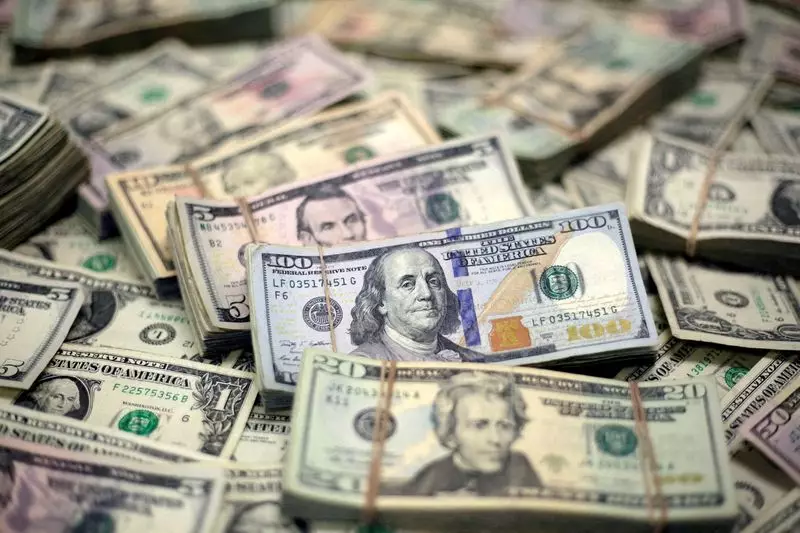As financial markets fluctuate, the value of the U.S. dollar has shown remarkable strength, reaching a two-month peak this week against other major currencies. This surge is driven by anticipations surrounding the Federal Reserve’s monetary policy, especially in light of recent economic indicators that showcase a resilient U.S. economy. Particularly noteworthy is the close proximity of the dollar’s value to key psychological levels, notably against the Japanese yen, which is teetering near the critical mark of 150 yen per dollar. Such dynamics in currency exchange rates are reflective of broader economic sentiments and uncertainties, as investors grapple with potential shifts in fiscal policies.
The undercurrents of the foreign exchange market are significantly influenced by the actions and statements made by the Federal Reserve. Recent data points to a mild deceleration in economic growth, accompanied by a slightly higher inflation rate in September than experts had anticipated. These factors have tempered the initial expectations regarding aggressive interest rate cuts from the Fed in the immediate term. Instead, market participants have begun recalibrating their forecasts, now assigning a staggering 89% probability to a modest 25 basis point reduction in the upcoming Federal Open Market Committee (FOMC) meeting. Additionally, there are predictions of a cumulative easing of 45 basis points by the end of the year, signaling a cautious yet deliberate approach to monetary policy.
This environment of increased dollar valuation is mirrored in the dollar index, which has recently rebounded by 2.5%, breaking a detrimental three-month slump. A notable comment by Fed Governor Christopher Waller advocating for “more caution” regarding interest rate reductions further solidified the dollar’s standing. His insights into potential disruptions in job market data due to natural disasters and strikes illustrate the complexities faced by policymakers when navigating economic challenges.
The performance of the yen has been particularly affected by recent shifts in the Bank of Japan’s policy stance. Governor Kazuo Ueda’s dovish rhetoric, coupled with new Prime Minister Shigeru Ishiba’s unexpected reluctance to endorse further rate hikes, has left substantial uncertainty regarding the future of monetary tightening in Japan. Currently, the yen is positioned perilously close to the critical psychological threshold of 150 per dollar, a level last breached on August 1. The continuing depreciation of the yen raises substantial questions about systemic economic resilience within Japan and the potential implications for its economy moving forward.
Market analysts suggest that the yen’s vulnerability could likely persist if the Federal Reserve works to tighten its monetary reins while Japan remains entrenched in ultra-loose monetary strategies. This divergence in monetary policies between the two economic powerhouses adds another layer of complexity for currency traders, who often rely on economic indicators to guide investment decisions.
In parallel, the euro nudged slightly lower during early Asian trading sessions, closely trailing its lowest values since early August. As anticipation builds for the European Central Bank’s policy meeting scheduled later this week, market participants are bracing for potential interest rate cuts that could further influence the euro’s performance. The observed steadiness in asset values from Australia and New Zealand indicates a cautious optimism in the Asia-Pacific region amid global economic fluctuations.
Additionally, the Chinese market’s expectations are altering investors’ strategies, with discussions revolving around rumors of increased fiscal stimulus as the government considers raising significant funds through Treasury bonds to rejuvenate its own sluggish economy. These speculative moves may instigate shifts in investor sentiment towards risk assets and currencies, especially as the National People’s Congress is set to deliberate on economic policies.
The current landscape of foreign exchange is marked by a blend of resilience and uncertainty as various macroeconomic factors come into play. The interplay between the Federal Reserve’s cautious approach, Japan’s stagnating monetary policy, and the ongoing ramifications of global economic tensions will continue to impact currency valuations. As market participants await forthcoming data releases and central bank decisions, the focus will remain on navigating this complex economic milieu. Investors would do well to stay vigilant, interpreting data and policy hints as they endeavor to forecast future movements in the ever-volatile currency markets.


Leave a Reply